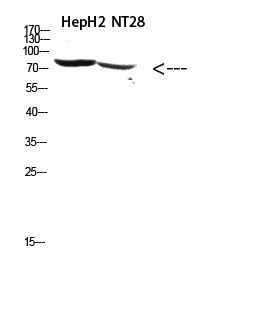RSK3 Polyclonal Antibody
- Catalog No.:YT5839
- Applications:WB;IHC;IF;ELISA
- Reactivity:Human;Mouse
- Target:
- RSK3
- Fields:
- >>MAPK signaling pathway;>>Oocyte meiosis;>>mTOR signaling pathway;>>Thermogenesis;>>Long-term potentiation;>>Neurotrophin signaling pathway;>>Progesterone-mediated oocyte maturation;>>Insulin resistance;>>Yersinia infection;>>Chemical carcinogenesis - receptor activation
- Gene Name:
- RPS6KA2 MAPKAPK1C RSK3
- Protein Name:
- ribosomal protein S6 kinase, 90kDa, polypeptide 2; hypothetical LOC100127984
- Human Gene Id:
- 6196
- Human Swiss Prot No:
- Q15349
- Mouse Gene Id:
- 20112
- Mouse Swiss Prot No:
- Q9WUT3
- Immunogen:
- Synthetic peptide from human protein at AA range: 330-400
- Specificity:
- The antibody detects endogenous RSK3 protein
- Formulation:
- Liquid in PBS containing 50% glycerol, 0.5% BSA and 0.02% sodium azide.
- Source:
- Polyclonal, Rabbit,IgG
- Dilution:
- WB 1:500 - 1:2000. IHC 1:100 - 1:300. ELISA: 1:5000.. IF 1:50-200
- Purification:
- The antibody was affinity-purified from rabbit antiserum by affinity-chromatography using epitope-specific immunogen.
- Concentration:
- 1 mg/ml
- Storage Stability:
- -15°C to -25°C/1 year(Do not lower than -25°C)
- Other Name:
- RPS6KA2 MAPKAPK1C RSK3
- Observed Band(KD):
- 80kD
- Background:
- ribosomal protein S6 kinase A2(RPS6KA2) Homo sapiens This gene encodes a member of the RSK (ribosomal S6 kinase) family of serine/threonine kinases. This kinase contains two non-identical kinase catalytic domains and phosphorylates various substrates, including members of the mitogen-activated kinase (MAPK) signalling pathway. The activity of this protein has been implicated in controlling cell growth and differentiation. Alternative splice variants, encoding different isoforms, have been characterized. [provided by RefSeq, Jan 2016],
- Function:
- catalytic activity:ATP + a protein = ADP + a phosphoprotein.,cofactor:Magnesium.,enzyme regulation:Activated by multiple phosphorylations on threonine and serine residues.,function:Serine/threonine kinase that may play a role in mediating the growth-factor and stress induced activation of the transcription factor CREB.,PTM:Autophosphorylated on Ser-377, as part of the activation process.,similarity:Belongs to the protein kinase superfamily.,similarity:Belongs to the protein kinase superfamily. AGC Ser/Thr protein kinase family. S6 kinase subfamily.,similarity:Contains 1 AGC-kinase C-terminal domain.,similarity:Contains 2 protein kinase domains.,subunit:Forms a complex with either ERK1 or ERK2 in quiescent cells. Transiently dissociates following mitogenic stimulation.,tissue specificity:Expressed in many tissues. Highest expression in lung and skeletal muscle.,
- Subcellular Location:
- Nucleus . Cytoplasm .
- Expression:
- Widely expressed with higher expression in lung, skeletal muscle, brain, uterus, ovary, thyroid and prostate.
Rps6ka2 enhances iMSC chondrogenic differentiation to attenuate knee osteoarthritis through articular cartilage regeneration in mice BIOCHEMICAL AND BIOPHYSICAL RESEARCH COMMUNICATIONS Guang-Qian Zhou WB Human mesenchymal stem cell
- June 19-2018
- WESTERN IMMUNOBLOTTING PROTOCOL
- June 19-2018
- IMMUNOHISTOCHEMISTRY-PARAFFIN PROTOCOL
- June 19-2018
- IMMUNOFLUORESCENCE PROTOCOL
- September 08-2020
- FLOW-CYTOMEYRT-PROTOCOL
- May 20-2022
- Cell-Based ELISA│解您多样本WB检测之困扰
- July 13-2018
- CELL-BASED-ELISA-PROTOCOL-FOR-ACETYL-PROTEIN
- July 13-2018
- CELL-BASED-ELISA-PROTOCOL-FOR-PHOSPHO-PROTEIN
- July 13-2018
- Antibody-FAQs
- Products Images

- Western Blot analysis of hepg2, NT28 cells using Antibody diluted at 500. Secondary antibody(catalog#:RS0002) was diluted at 1:20000

- Western blot analysis of lysates from 293 cells, using Rsk-3 antibody.



